A double lens is known as an achromatic lens. Discolouring and imaging defects of a single lens are eliminated through the use of an achromatic lens. Good binoculars have at least one achromatic lens in each of the objective and ocular lens system. When the double lens is divided by a thin air gap it is called an air-achromatic lens. The length of the binocular can be decreased substantially through the use of airachromats.
The Binoculars
In 1854, the Italian army officer Ignaz Porro created a monocular telescope with an erecting prism. This construction enabled the manufacturing of substantially smaller devices with a much larger field of view. At that time, the required precision workmanship and glass material were not up to the necessary standards. Only in 1893 it was possible for Ernst Abbe to create the first mass produced Porro-prism binocular with acceptable optical performance.

At the beginning of the 20th Century Moritz Hensold began working on a new prism system which, compared to the Porro-system was slimmer and enabled larger Objective diameters. This new Roof-system was patented in 1905. All binoculars created today are based on these two prism systems.
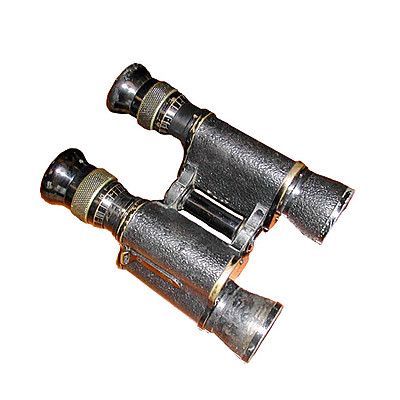
2. The Characteristics
2.1 The Classification Numbers
How much one can see with a binocular depends on its magnification power and its objective diameter. The first number on any binocular is its magnification power, the second and last identifies the size of the objective diameter in millimetres. Therefore a 7x50 binocular has a magnification power of 7 times (7x) and the objective diameter is 50mm. The relationship between these two are very relevant during dawn observation. These classification numbers are only good for comparison of the different sizes of binoculars, not different types (8x30, 8x40, 7x50, 16x50 etc.) They do not portray any information in regards to the Quality of the binocular components. Therefore they do not take into consideration the increase in performance due to coatings and higher quality glass material.

2.2 Magnification
A 7x50 binocular, therefore has a 7 times magnification. This value indicates the apparent magnification of the observed object. This means that an object 700m (700 yards) away can be viewed as if it was only 100m (100 yards) away. However, one cannot say that the higher the magnification of a binocular is, the better the binocular. Higher magnifications also cause poorer detail perceptibility. Whether it be through the perception of your hand wobbling increasingly (because of the higher magnification) or because of the dimmer picture quality.
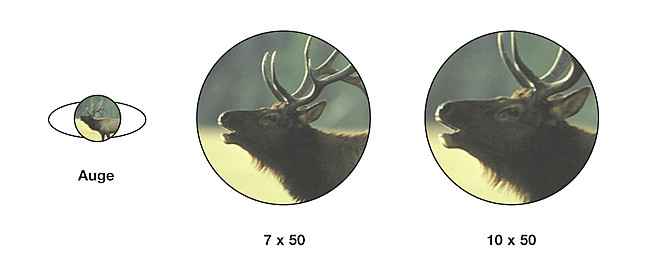
2.3 The Objective diameter
The second classification number deals with the objective diameter in mm (millimetres). Therefore a 7x50 binocular has an objective diameter of 50mm. This is an important performance trait, because the higher the objective diameter is, the larger is the light transmission and therefore the picture is brighter. A diameter of 21mm (8x21) is sufficient for daytime observation. For observations during dawn or dusk, a diameter of 50mm or better is recommended.
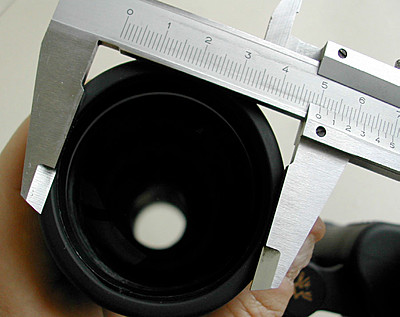
2.4 Exit Pupil
The exit pupil is the light dot which exits the ocular side of the binocular and hits the eye. The exit pupil is important for dawn and dusk observations. The larger it is the brighter the picture transmission to your eye. It can be calculated by using this formula:
For example a 7x50 binocular
(Objective diameter / Magnification Power)
e.g. 50 / 7 = 7.14

The maximum opening of the human pupil depends on the eyes and the age of the observer. The ability to enlarge ones pupils during darkness decreases with increasing age. The pupils of a young person can enlarge up to 7mm. However, the pupils of a 50 year old can only increase to 5mm. Because of this, the enlarged exit pupil of a 7x50 can no longer be utilized to its fullest by an older observer. Therefore a lighter 8x40 binocular with an exit pupil of 5mm would be a wiser choice. However, a larger exit pupil can still be of benefit to an older person as well. During “movement” observation or during observation on a boat (a moving standpoint) the pupil of the observer will not wander as fast out of the exit pupil diameter and therefore the field of view cut off.
2.5 Relative Light Intensity Indicator
Usually animals can be observed excellently during dawn and dusk. Especially, during these day times the light conditions are not suitable for observations with the naked eye. This is the reason why binoculars need to be so much better, so that individual details can easily be recognized.
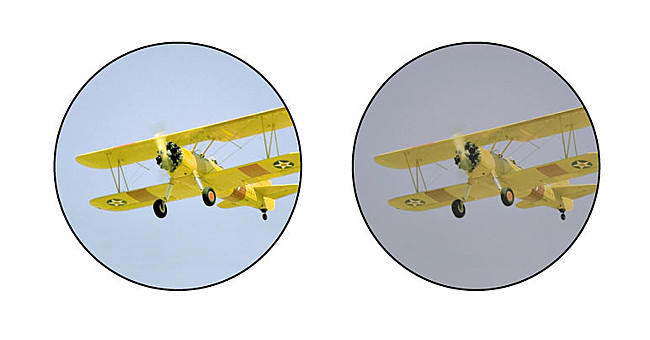
Binoculars must have at least a magnification power of 7-times and an objective diameter of no less than 50mm, so that the relative light intensity is high enough for dawn and dusk. This indicator shows in relation to other types of binoculars how much detail can be seen during poor light conditions. The higher the indicator, the better the light transmission of the binocular. The indicator can be calculated by using the following formula:
The Root of the magnification power x the objective diameter
e.g. ?7x50 = 18,07
2.6 Light Intensity Indicator
A further indicator for the calculated brightness of a binocular is its light intensity. Models with a high light intensity are also suitable for observation at dawn and dusk. This indicator is calculated by using this formula:
For example a 7x50 binocular
(Objective diameter divided by the magnification)2
e.g. 50 / 7 = 7.14 then 7.142 or 7.14 x 7.14 = 51
The calculation of light intensity and relative light intensity do not take into consideration performance enhancers such as Barium-Crownglass (BaK-4) or multi-coatings.
2.7 Interpupillary Distance
The interpupillary distance is the distance between the exit pupils of both oculars. It can be changed by adjusting the bridge and therefore moving the objective tubes either further apart or closer together until it is fitted to the observers eyes.
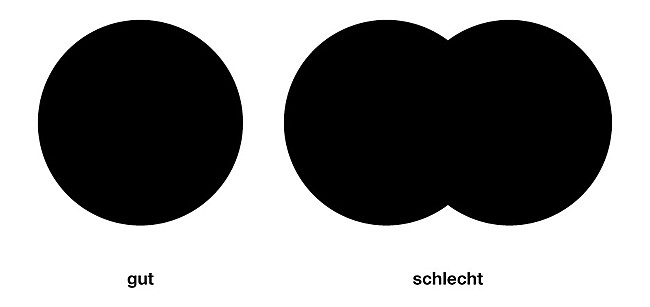
2.8 Eye Distance
This value indicates how far the eye can be away from the eyepiece until the sight of the entire field of view is lost. Through the use of foldable, turnable or pullable eyecups, the eye-distance can be changed with almost all binoculars making it possible for spectacle wearers to comfortably observe with their glasses on.
2.9 Field of View
The size of the field of view is also printed on most binoculars (besides the magnification and objective diameter). It is indicated in relation of X m at 1000m distance, or as an angle. A field of view of 101m at 1000m means that the observer can see a 101m wide spectrum at 1000m distance. Obviously, the larger the magnification the smaller the field of view. However, the field of view can be increased through special optical constructions (i.e. Bresser SWA). Binoculars without special optical constructions but with a large field of view often suffer unsharpness on the outer ring of the field of view.
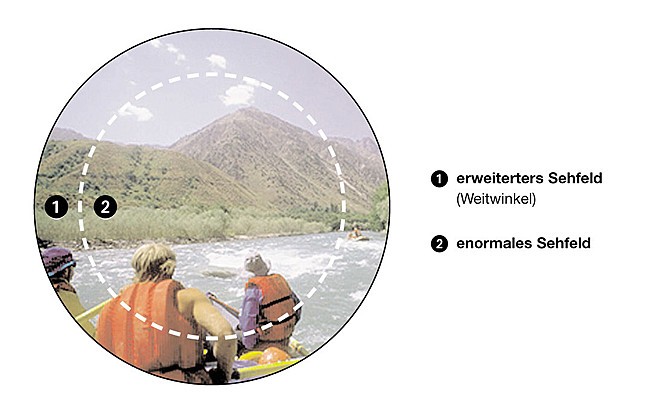
An easy check for this defect is the observation of detailed structures such as a fence or wall and comparing the sharpness from edge to edge. A field of view angle can be converted to metres by multiplying it by 17.45. Therefore a field of view of 101m is an angle of 5.79 degrees.
2.10 Focusing
There are two main focussing types for binoculars: single ocular focus and centrewheel focus. Centre-wheel focusing binoculars are easier and faster to focus and therefore, can follow moving objects much easier. Binoculars with single ocular focus are often found in marine use. A complete waterproofed body is warranted because of the single ocular focus. Waterproofed models with centre-wheel focus are still fairly new on the market. But because of their robustness the single ocular focus remains choice number one for marine use.
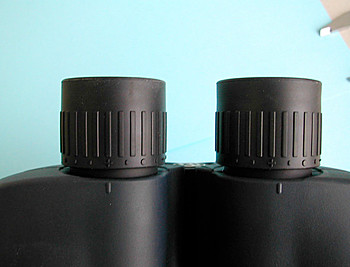
2.11 Rubber armoured
Rubber armoured binoculars can be recommended for “heavy duty” work. The black or olive green rubber armour protects the binocular from bumps, knocks and other minor impacts and water resistant (but not water proofed).
3. The Glass
3.1 Coating
Generally, "coated" means that some lens surfaces have been covered with a thin layer of material that reduces unwanted reflections and glare to increase light transmission and contrast. A fully multi-coated binocular transmits up to 60% more light than a non-coated glass. Through the use of special coatings it is possible to further increase the light transmission. (e.g. Montana 7x42)
Ruby or red coating is another specialty. These binoculars contain 7 to 15 ruby coloured layers on the objective lens. This coating enhances the contrast during bright sunshine (i.e. Cobra). However, the luminosity decreases up to 7% through this coating.
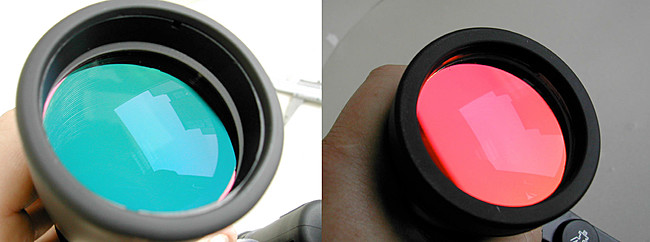
Partially Coated
Partialy coated means that the outer objective and ocular lenses have been coated.
Fully Coated Lenses
Fully coated means that all air-to-glass lens surfaces and usually the long side of the prism have been coated.
Multi Coated Lenses
Multi coated means that multiple layers have been applied to one or more surfaces to further reduce reflections.
Fully Multi Coated Lenses
Fully multi coated means all air-to-glass surfaces (and possibly the long side of the prism) have multiple layers of coatings.
3.2 The Glass materials
Bresser and Meade binoculars are constructed with either BK-7 or BaK-4 prisms and lenses. An easy way to test which glass is being used is to look through the ocular lens while holding the binocular 30-40 cm away from the eye into a bright background. If the exit pupil is rectangular then the glass used in the binocular is BK-7. If the exit pupil is round and without any shadows then the best BaK-4 glass material has been used. BaK-4 binoculars are the higher quality binoculars as they produce a brighter and detail richer picture. An example of a Bk-7 glass is the Speed binocular. (Speed also has the stop and go functioning centre-wheel). An example of a BaK-4 glass is the Luchs binocular.
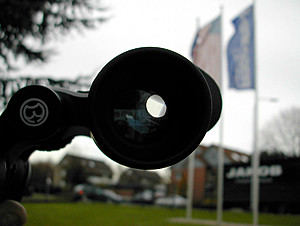
3.3 Porro or Roof Prisms
The type of prism used, defines the construction body of the binocular. The use of porro prism leads to wide binoculars. Because of the larger objective distance in the porro system the observed object seems a little “plastic”. This can be noticed at high magnifications and short distance observation. Roof binoculars are compacter and handier.
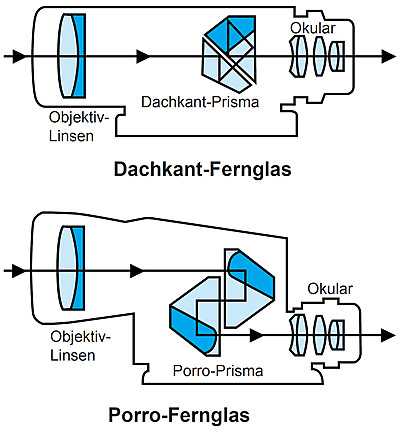
3.4 Achromatic Lens
4. Types of Binoculars
4.1 Binocom and Nautic
The Binocom and Nautic binoculars are specifically made with watersport and marine use in mind. These binoculars are filled with a nitrogen gas to prevent water from leaking into the binoculars. These binoculars are available in pocket-binocular size as well as full sized, even with centre-focus. Several binoculars even have a built in compass, such as the Binocom and Nautic II models.
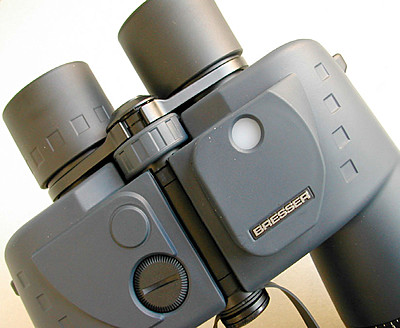
4.2 Night binoculars and Nightvision
Night binoculars are binoculars that have a high light power. (i.e. 7x50, 8x56, 9x63). An excellent “night binocular” is the 8x56 Linear or Diorit.
Night binoculars are not to be mistaken with nightvision devices.
4.3 Light enhancers / Night Vision Equipment
Nightvision devices are light enhancers and are designed for night time use. These devices use whatever light source is available, whether it be moonlight or the light from stars and enhance it up to 15,000 times. The use of an infra-red lamp with a nightvision device appears like a flashlight and further brightens the picture. The infrared lamp also enables observation in absolute darkness.
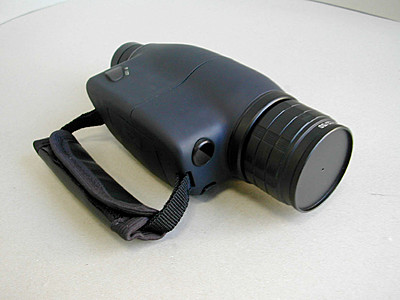
Caution:
The electronic picture of a nightvision device cannot be compared with a binocular in terms of picture quality, and sharpness. Most of the time the picture appears green.

 Deutsch
Deutsch
 English
English
 Francais
Francais
 Español
Español
 Italiano
Italiano
 Nederlands
Nederlands
 Polski
Polski
